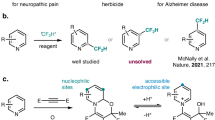Abstract
THE complex family of non-specific carboxylic esterases has been subdivided into different groups, principally on the basis of the results of inhibitor and activator studies1. One of the most important substances for this purpose is E600 (diethyl-p-nitrophenyl phosphate), which has been used extensively—both biochemically and histochemically—to distinguish between the A and C esterases, which are resistant to organophosphate and unaffected by concentrations of less than 10−3 molar E600, and the B esterases, which are sensitive to organophosphate and are completely inhibited by 10−5 molar E600 (ref. 2). In a histochemical study of indoxylesterases in rat kidney and other tissues, Hess and Pearse3 found that ‘Mipafox’ (N,N′-di-isopropyl phosphorodiamidic fluoride) at a concentration of 10−3 moles/l. gave a complete inhibition of B esterases similar to that obtained with 10−5 molar E600, allowing the subsequent demonstration of A and C esterases. In other tissues4, however, it has been found that under histochemical conditions a much higher concentration of E600 than 10−5 moles/l. is required to produce an inhibition comparable with that of 10−3 molar ‘Mipafox’. Increasing concentrations of organophosphate have a progressive inhibiting effect histochemically, which makes it difficult to distinguish clearly between organophosphate-sensitive and organophosphate-resistant enzyme species in terms corresponding to those of biochemical studies.
This is a preview of subscription content, access via your institution
Access options
Subscribe to this journal
Receive 51 print issues and online access
$199.00 per year
only $3.90 per issue
Buy this article
- Purchase on Springer Link
- Instant access to full article PDF
Prices may be subject to local taxes which are calculated during checkout
Similar content being viewed by others
References
Aldridge, W. N., Biochem. J., 57, 692 (1954).
Pearse, A. G. E., Histochemistry, Theoretical and Appfied (Churchill, London, 1960).
Hess, R., and Pearse, A. G. E., Brit. J. Exp. Path., 39, 292 (1958).
Bulmer, D., J. Roy. Micros. Soc., 84, 189 (1965).
Smithies, O., Biochem. J., 71, 585 (1959).
Eränkö, O., Härkönen, M., Kokko, A., and Räisänen, L., J. Histochem. Cytochem., 12, 570 (1964).
Niemi, M., Härkönen, M., and Kokko, A., J. Histochem. Cytochem., 10, 186 (1962).
Author information
Authors and Affiliations
Rights and permissions
About this article
Cite this article
BULMER, D., FISHER, A. Inhibition of Rat Liver Esterases by Organophosphorus Compounds. Nature 213, 202–203 (1967). https://doi.org/10.1038/213202a0
Issue Date:
DOI: https://doi.org/10.1038/213202a0
This article is cited by
Comments
By submitting a comment you agree to abide by our Terms and Community Guidelines. If you find something abusive or that does not comply with our terms or guidelines please flag it as inappropriate.



